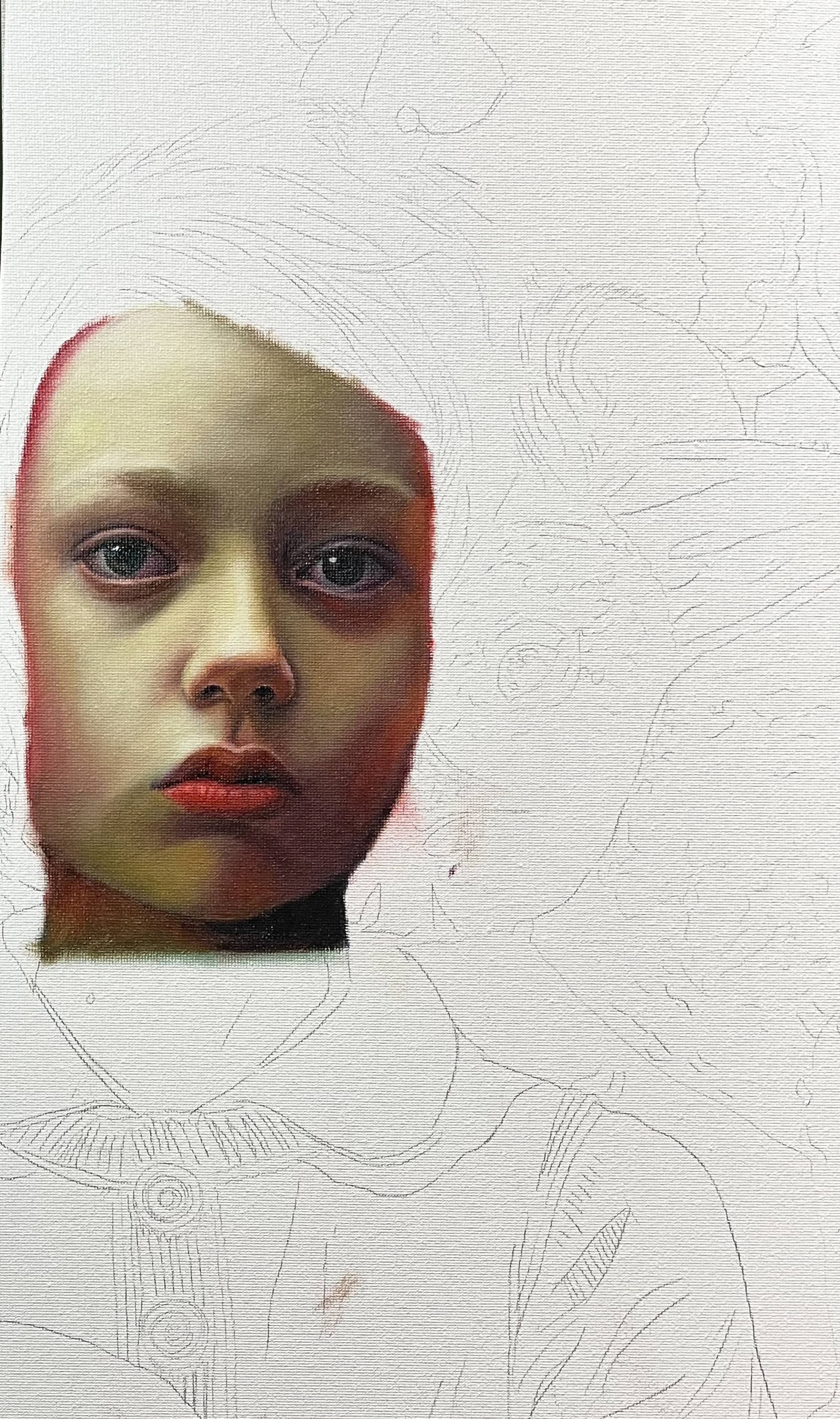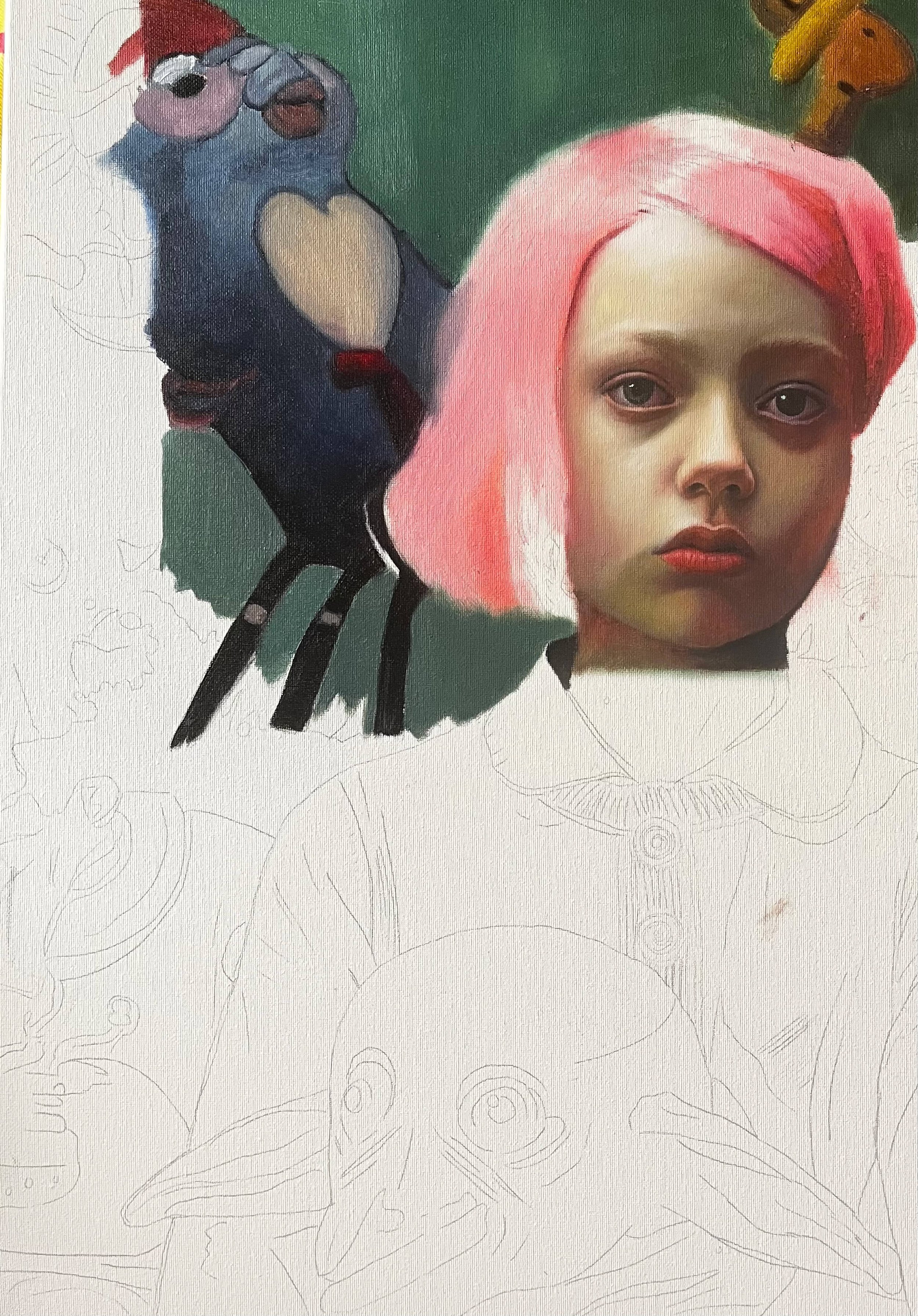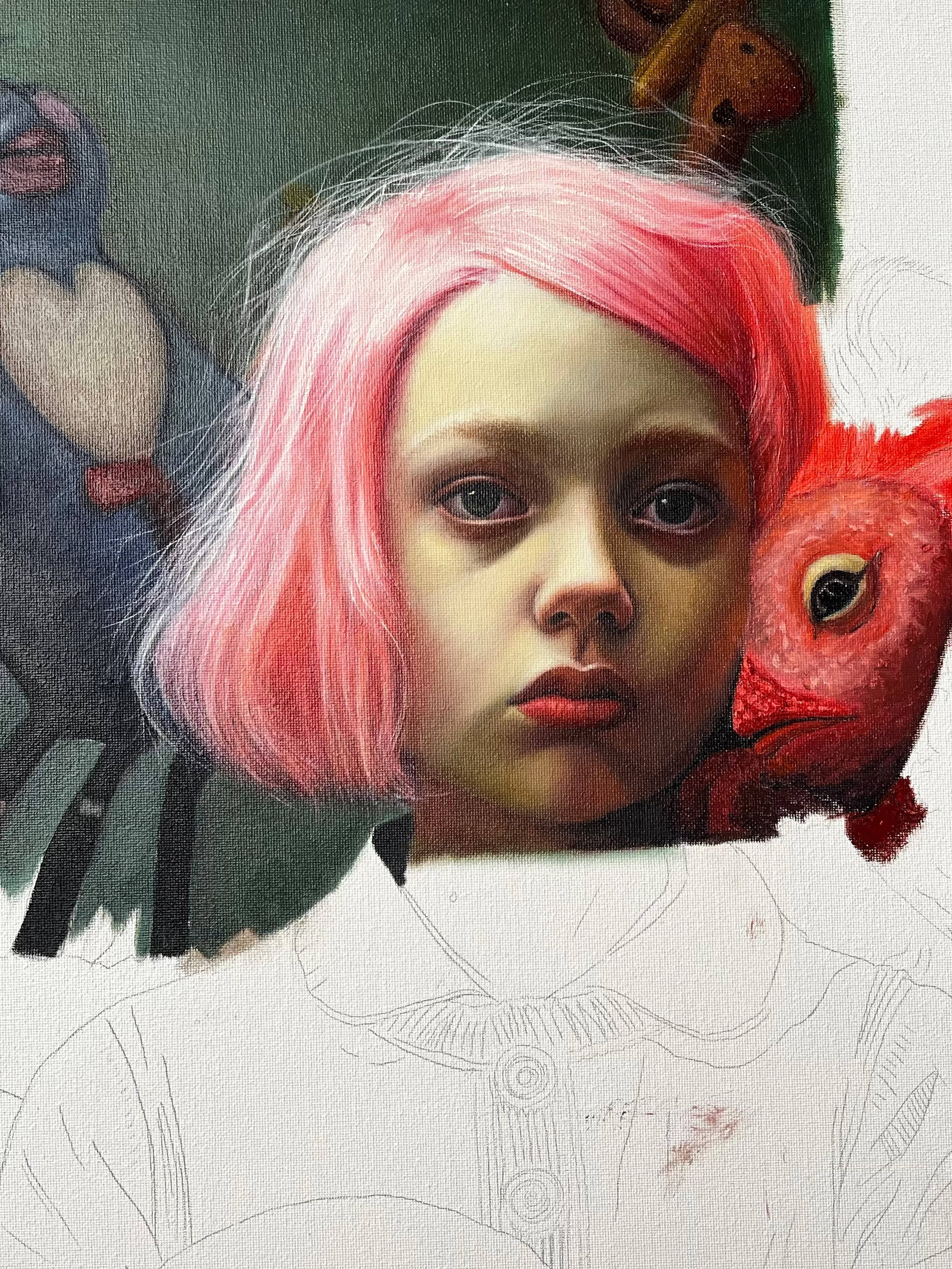Artist Sofía Ruiz
Congratulations to Sofía Ruiz for earning her place a Winner in the Boynes Artist Award 9th Edition [Professional Artist category]!
Who are you?
I am a Latin American artist from Costa Rica. I started drawing when I was 5 years old because my father gave me some small notebooks to keep me occupied while my mom was in the hospital. However, it wasn't until I was 16 that I bought tattoo magazines to try creating some designs. That was the moment when I discovered my ability to draw and found it came easily to me. After that, I began learning more and started painting with oils. I also took art classes. At some point while studying Chemical Engineering and Philosophy, I decided that I wanted and needed to follow an artistic path. So, I changed my career direction and enrolled in the School of Fine Arts in CR. After a few years, I specialized in Painting and Printmaking.
“Good Listener”
Oil on Canvas
By Sofía Ruiz
What inspired you to utilize painting as a medium?
I appreciate painting for its broad range of technical options. There's a variety of choices, including watercolor, acrylic, mixed media, oils, and more. It lets you focus on detail, texture, and color all at once. As an artist, I relish the challenge of continuous learning and improvement that this medium offers. Painting also allows me to work at my own pace. I can be in a creative flow for an entire day or pause and resume a piece later. The capacity to blend colors and textures drew me to this medium, which allows me to mix realism and abstraction to capture emotions, stories, and ideas in a tangible visual form—it's a language of its own.
“Mental Shelter”
Oil on Canvas
By Sofía Ruiz
How would you describe your work?
I work with a variety of techniques. I mostly paint with oil and acrylic paints, but I also engage in etchings, silkscreen, woodcuts, and photogravures. My artwork is a fusion in which I blend traditional realism with surreal and abstract qualities. This fusion enables me to explore concepts of otherness and identity. Topics tied to psychoanalysis have always intrigued me, as they offer explanations for what lies within us. This exploration also serves as a means to understand certain autobiographical elements from my childhood.
I'm also curious about the fragility of memory and how it shapes our sense of self. Duality is a recurring theme in my work, as I examine the coexistence of fluidity and fixity within our identities. This is why my paintings often depict figures and styles divided or containing elements in tension with each other. The synthesis of traditional realism, demanding meticulous planning and detail, with abstract textures created through spontaneous moments, seeks to explore our reconciliation of conflicting aspects within ourselves.
“Safety”
Oil, Acrylic & Thread on Canvas
By Sofía Ruiz
Can you discuss the inspiration and thought process behind your winning work?
"Mysterious Allies" drew inspiration from what I call a glimpse into my distorted childhood. It is one of my newest paintings in a series of works that explore a sense of otherness and loss of identity that I felt while my mom suffered from amnesia during my childhood. I felt like an outsider in my own family, so this painting features a kid that is isolated or disconnected from her surroundings. It shows the dualities and complexities in ourselves that can be fluid and fixed. The style contains multiple elements that are in tension with one another, to explore the ways in which memories can be fixed, distorted, or lost over time. I sought to embody this imperfection—a hidden, incomplete, and detached facet of childhood.
My intention was to express the interplay between apparent normalcy and transient beauty, juxtaposing a delicate, innocent, and intricate child figure with darkness, surreal monsters, imaginary friends, abstract strokes, and symbols.
“Mysterious Allies”
Oil on Canvas
By Sofía Ruiz
Can you walk us through the technical steps of creating your winning work?
Starting a painting lacks a strict formula, but every piece shares a common objective in my case—to weave distinct images into a cohesive narrative that I want to express. This piece is part of a new series of works that delve into the minds of kids with disconnected memories and strange childhoods. I wanted to show a world full of imaginary and disconnected elements that somehow form a landscape of who they are or how they connect to the world.
My initial step involves identifying the diverse elements that will contribute to the composition and story. This creative process is like a game demanding patience and time. My approach is to integrate selected figures to construct a narrative, much like assembling a puzzle. Over time, I observe how various elements encountered along my journey connect, often in ways not immediately apparent, yet forging a sense of inexplicable resonance. In this case, I used toys, masks, and stuffed animals. Once I've played with transforming them and finalized the different elements and aspects of my characters, I create a more finished sketch to work out the details on my computer. I like working this way because when I paint, I don’t like to think too much about the image itself, so I plan that beforehand. Then I take my finished sketch to the size of my canvas, print it out, and transfer it using graphite paper.
After that, I initiated the painting process. When I work, thinking happens before or after I’m painting; during creation, I'm more in a trance-like state. I just let myself go, and the decisions are more about color and texture. I typically start with the face of my central character, followed by the rest, and I often work in layers of painting to achieve the desired effects and textures. The process of making this painting took me around two months.
What do you hope to communicate to an audience with your work?
I aspire to evoke introspection and foster connections within my audience. Through my art, my aim is to kindle emotions, ignite conversations, and offer a fresh perspective.
“Ruido y Ausencia”
Oil & Acrylic on Canvas
By Sofía Ruiz
Can you talk about your biggest learning experience during the process of creating your work?
For me, the most valuable lesson was trusting the creative process. When I began this piece, I felt intimidated to paint it. I thought I didn’t have the skill to achieve it the way I'd like to. Sometimes uncertainty about the end result or whether desired outcomes will be achieved can be daunting. In that moment, patience becomes essential. Persisting in the creative endeavor, even when clarity is lacking, is crucial to ultimately achieving clarity and reaching your goals. Sometimes, while a plan may provide guidance, flexibility and adaptability are equally vital.
“The Bird”
Oil & Acrylic on Canvas
By Sofía Ruiz
Can you discuss your biggest success since starting your artistic journey?
I think being part of a group show at the Palais de Tokyo Museum in Paris in 2014 stands out for me because it is one of Europe's largest centers for contemporary art. Being selected for this opportunity was truly astonishing. Additionally, I consider a series of smaller successes instrumental, as they collectively have given me the chance to continue painting and creating over the long term.
“Pesadilla”
Oil & Acrylic on Canvas
By Sofía Ruiz
Can you give us a piece of advice you wish you had known at the start of your career?
Embrace the capacity to evolve and adapt your artwork. If you need to change, don't shy away from experimenting, trying new techniques, and exploring different creative avenues. Moreover, recognize the significance of networking, forming connections, and engaging in collaborations within the art community.
“Imaginary Friend”
Oil & Acrylic on Canvas
By Sofía Ruiz
What projects are you working on currently?
Currently, I'm working on the first pieces for what I plan to be my next solo show. "Mysterious Allies" is one of them, in which I explore a mix of realism and surreal creatures.
“Daydreamer”
Oil & Acrylic on Canvas
By Sofía Ruiz
What is your dream project or piece you hope to accomplish?
My constant project revolves around the next painting, that it will be better than the last one, because I always want to improve my work, mostly for myself, but it will be very nice to be able to showcase my artwork in diverse public spaces, galleries, and museums. I also want to publish an art book.
As a winner, do you have any advice for artists who want to submit to awards, competitions, residencies, etc.?
Don't hesitate to submit your work! Each submission is an opportunity to gain exposure, learn from feedback, and connect with other artists. Be persistent and believe in the value of your creations.
“Contemplation”
Oil on Canvas
By Sofía Ruiz
Lastly, I like to ask everyone what advice they would give to their fellow artists, what is your advice?
Embrace experimentation and growth. Stay open to new techniques, ideas, and critiques. Your journey as an artist is a continuous evolution—enjoy the process and let it shape your unique artistic voice.
To view more of Sofía Ruiz












